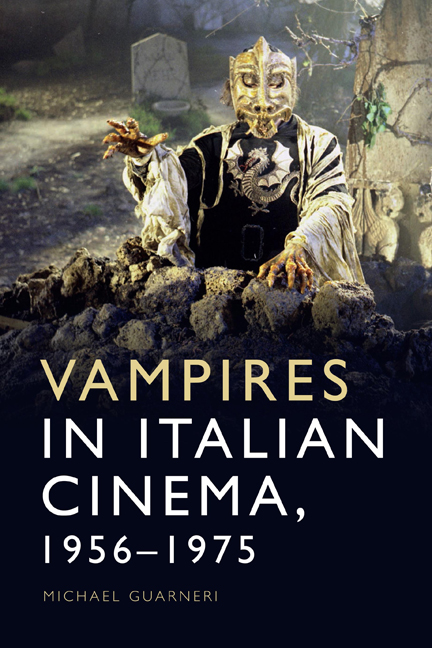Book contents
- Frontmatter
- Contents
- Figures and tables
- Acknowledgements
- Introduction
- PART I THE INDUSTRIAL CONTEXT
- PART II VAMPIRE SEX AND VAMPIRE GENDER
- PART III SANGUINE ECONOMY, BLOODY POLITIC
- Appendix A Three Italian vampire films that were never made
- Appendix B Files from the Italian Show Business Bureau fonds at the Archivio Centrale dello Stato in Rome
- Bibliography
- Index
Introduction
Published online by Cambridge University Press: 10 October 2020
- Frontmatter
- Contents
- Figures and tables
- Acknowledgements
- Introduction
- PART I THE INDUSTRIAL CONTEXT
- PART II VAMPIRE SEX AND VAMPIRE GENDER
- PART III SANGUINE ECONOMY, BLOODY POLITIC
- Appendix A Three Italian vampire films that were never made
- Appendix B Files from the Italian Show Business Bureau fonds at the Archivio Centrale dello Stato in Rome
- Bibliography
- Index
Summary
NEW BLOOD FOR THOUGHT
For more than 200 years now, the vampire has been one of the most popular characters in fiction across media all over the world. The term ‘vampire’ became a buzzword throughout Western Europe thanks to police inquiries, medical reports and religious treatises compiled in the wake of the epidemics that scourged Eastern and Southeast Europe between the late seventeenth and the early eighteenth century (Dimic 1984; Wilson 1985; Groom 2018: 23–40, 56–94), but it was not until the publication of John Polidori's short story The Vampyre in 1819 that the bogeyman became a cash cow. The key to commercial success was simple: with a felicitous intuition undoubtedly inspired by his working experience as Lord Byron's travelling physician, Polidori turned the Slavic folklore's ‘plump and ruddy’ (Barber 2010: 4), ‘repulsive, smelly, poor’ (Douglas 1967: 36) peasant revenant preying on fellow villagers and livestock into a thin, pale, rich, elegant, urbane, sexually attractive aristocrat – a template that would be more or less faithfully followed by all the most popular male and female vampires to come, from Sheridan Le Fanu's 1871 novella Carmilla and Bram Stoker's 1897 novel Dracula to Anne Rice's The Vampire Chronicles book saga (1976–present) and Stephenie Meyer's Twilight book saga (2005–8); from the very many British and French theatre adaptations of Polidori's seminal tale to Hamilton Deane's and John L. Balderston's 1920s theatre adaptations of the Stoker novel; and from the Universal Dracula (Tod Browning, 1931) and the Hammer Dracula (Terence Fisher, 1958) to Bram Stoker's Dracula (Francis Ford Coppola, 1992), Interview with the Vampire (Neil Jordan, 1994), TV series Buffy the Vampire Slayer (1997–2003) and the Twilight film saga (2008–12).
As they branched out from folklore to literature, theatre, cinema and TV, vampires became popular in the academia too. Eastern European tales about the dead sucking the blood of the living started attracting scholarly attention at the beginning of the eighteenth century, when ‘learned essays on questions relating to superstition were by no means uncommon’, and vampire legends presented a special appeal to both the high ranks of the Catholic church (Augustin Calmet, Giuseppe Antonio Davanzati and Prospero Lambertini, among others) and those enlightened ‘philosophers […] who were pledged to the idea of progress [and] enjoyed amassing evidence about what they called the “primitive” and “dark” areas’ (Frayling 1991: 23).
- Type
- Chapter
- Information
- Vampires in Italian Cinema, 1956-1975 , pp. 1 - 20Publisher: Edinburgh University PressPrint publication year: 2020



